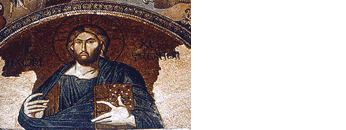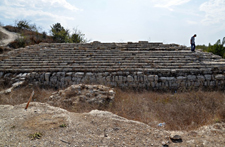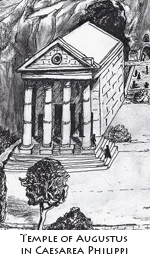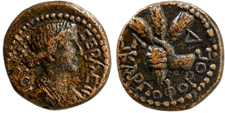
|
|
|
|
|
Artifact Analysis
|
|
|
|
- The Imperial Cult in
- Sebaste & Caesarea Philippi
-

Herod the Great signalled his loyalty to Emperor Augustus by building a Roman-style city on the site of the former capitol of the Northern Kingdom of Israel, Samaria. He renamed the city "Sebaste" (the Greek word that translates the Latin "Augustus"), and mimicked the architectural styles and city amenities that elite Romans would have expected. Most importantly, he built a Temple to Augustus, of which only the stairs remain.-
- The Jewish kings reserved such obviously Gentile buildings and rituals to their newly built, Roman-style cities, such as Sebaste and Caesarea Maritima (built by Herod the Great), Caesarea Philippi (built by H
 erod's son Philip), and Sepphoris and Tiberias (built by Herod's son Herod Antipas). We know that there were temples to Augustus in Sebaste and in Caesarea Philippi. Worship of the emperor as "Son of God" could not be performed in Jerusalem or the more Jewish settlements of Judea and Galilee, as there would have been too much popular opposition to both the Roman overlords and to their foreign gods. erod's son Philip), and Sepphoris and Tiberias (built by Herod's son Herod Antipas). We know that there were temples to Augustus in Sebaste and in Caesarea Philippi. Worship of the emperor as "Son of God" could not be performed in Jerusalem or the more Jewish settlements of Judea and Galilee, as there would have been too much popular opposition to both the Roman overlords and to their foreign gods.
-
- But the Jewish kings had more latitude in the new cities they built, in the coins they minted, and in rituals and spectacles they promoted, all of which honored the imperial family. For example, Herod the Great's son Philip, who inherited the northernmost part of Herod's kingdom in what is today the Golan Heights, minted the first known Jewish coin with a woman's image—Augustus' wife Livia, who was also the mother of the current Emperor Tiberius.

The coin, minted right about the time of Jesus' death (30 CE), shows Julia Sebaste on the obverse, and on the reverse an outstretched hand holding three ears of grain with the inscription karpophoros (fruit-bearer). Coins of the emperor himself would often show a benefit that he was thought to bring, such as peace or victory, on the reverse, while the obverse would have image of him and an inscription such as "Divi F" (for divi filius, "son of god").-
-
- Bibliography
-
- Ando, Clifford. Imperial Ideology and Provincial Loyalty in the Roman Empire, ClasCT 6. Berkeley: University of California Press, 2000.
-
- Kahn, Lisa C. "King Herod's Temple of Roma and Augustus at Caesarea Maritima." In Caesarea Maritima: A Retrospective after Two Millennia (ed. Avner Raban and Kenneth G. Holum; Documenta et monumenta Orientis antiqui 21; New York: E. J. Brill, 1996) 130-45. [Filed in the Caesarea Maritima dig team folder]
-
- Eliav, Yaron Z., Elise A. Friedland and Sharon C. Herbert, eds. The Sculptural Environment of the Roman Near East: Reflections on Culture, Ideology, and Power, Interdisciplinary Studies in Ancient Culture and Religion 9. Leuven: Peeters, 2008.
-
- Galinsky, Karl. Augustan Culture: An Interpretive Introduction. Princeton, New Jersey: Princeton University Press, 1996.
-
- Kenyon, Kathleen M. "Excavations at Samaria. The Forecourt of the Augusteum." Palestine Exploration Quarterly 65:2 (1933) 74-87.
-
- Price, Simon R. F. Rituals and Power: The Roman Imperial Cult in Asia Minor. Cambridge: Cambridge University Press, 1984.
-
- Reisner, George Andrew, Clarence Stanley Fisher and David Gordon Lyon. Harvard Excavations at Samaria, 1908–1910, vol. 1, Text. Cambridge, Massachusetts: Harvard University Press, 1924.
-
- Scott, Sarah and Jane Webster. Roman Imperialism and Provincial Art. New York: Cambridge University Press, 2003.
-
- Strickert, Fred. "The First Woman to be Portrayed on a Jewish Coin: Julia Sebaste." Journal for the Study of Judaism in the Persian, Hellenistic and Roman Periods 33:1 (2002) 65-91.
-
- Zanker, Paul. The Power of Images in the Age of Augustus. Ann Arbor: University of Michigan Press, 1990; original, 1988.
-
-
|
|
|
|
|
